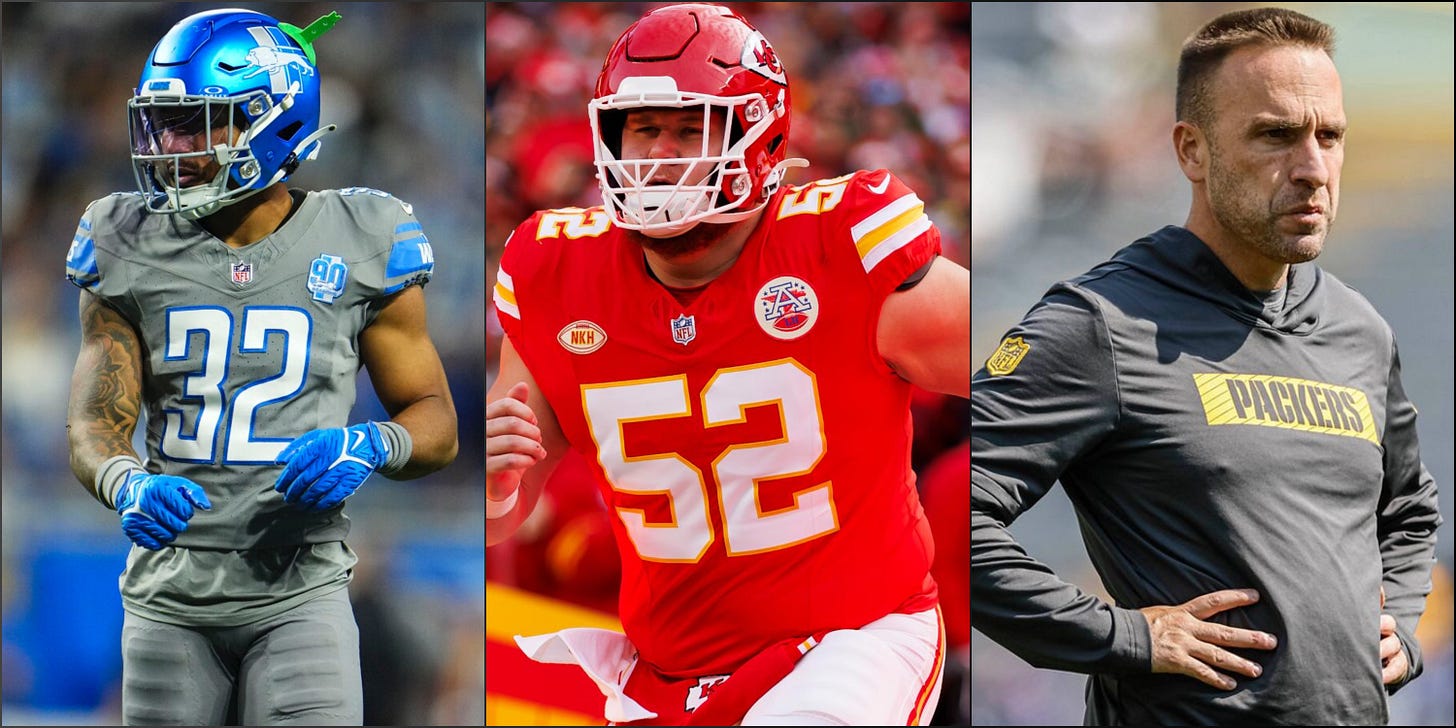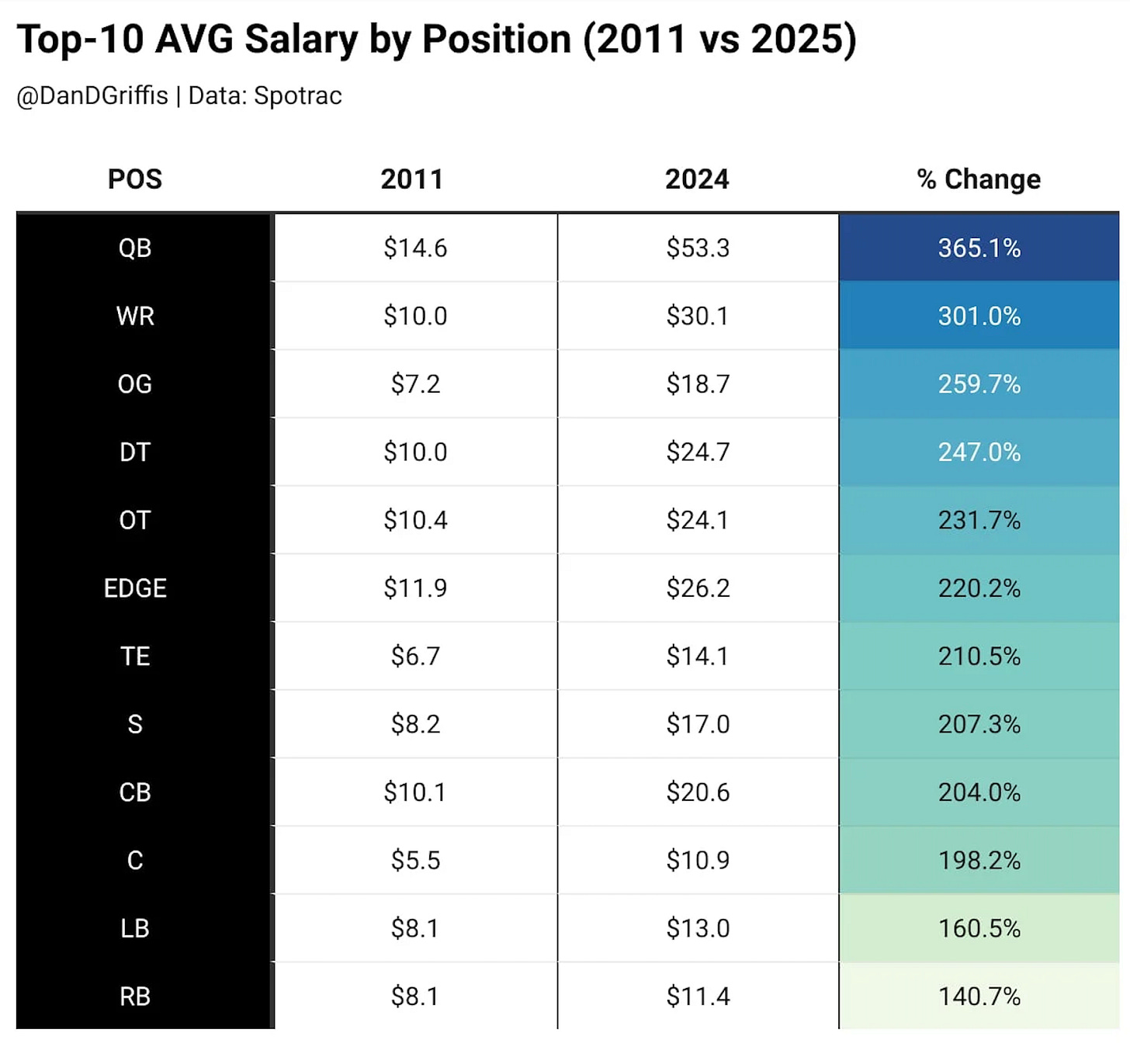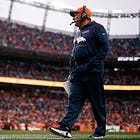August Mailbag: What's the most undervalued position in the NFL?
Answering reader questions on Jeff Hafley, simulated pressures, Oasis and the importance of centers
It’s mailbag time! If you want a question answered in the September edition, you can reply to this email or check out the chat feature on the Substack App. Football is back! Let’s do it.
The market dictates what teams believe certain positions are worth, but as the NFL landscape rapidly changes, do you believe there's any disconnect between the market values of certain positions and their actual on-field impact? (Could be a position that is being paid too much or too little.) Also, I would be interested to hear to what extent that evaluation changes when you look at the elite tier vs. starter tier (i.e., perhaps starting-level tackles are being overpaid, but elite ones are underpaid) – Eric Sidewater
The two positions that jump out to me are center and safety. That may be my coach brain seeping too much into the analyst side. But quality centers are as impactful to an offense as any non-quarterback. Ditto for a safety’s impact on modern defenses.
The demands on centers are heavy – and increasing. In most systems, they’re responsible for setting the blocking mechanics in the run and pass games. In some systems (like the Eagles), they’re responsible for setting and calling the run game, making adjustments based on the pre-snap shape of the defense.
I’ve written about this a ton, but the trend among the best defenses is to live in a pressure-and-disguise world. There are a ton of moving pieces, from mugged-up fronts and overload fronts to all the stunts, twists, and battery of pressures they’re throwing the way of offenses. Teams are finding increasingly crafty ways to break down protections – to set the protection for the offense and exploit it. And as much as blitz rates are booming, defenses are still looking to get pressure with just a four-man investment in the pass rush, using zone pressures, simulated pressures, and creepers to get home. Figuring out who is coming is tough. Making sure the protection remains even (we invest as much as they do or stay plus-one in protection) is essential.
All of that falls on the center. Finding a high-level center can be a cure-all for the problems presented by those different pressure looks. Can they read it? Can they adjust? Can they communicate it to everyone else? If the passing game is the most important function of offense, how is the guy trying to decipher what is being thrown its way not extraordinarily valuable? And that’s before you even touch on their impact in the run game, whether that’s changing the pre-snap mechanics or being an impactful puller and mover that gives the offense an “all-five-can-pull” flavor that every offensive staff is looking for in the modern game. Can they pull themselves? Are they the guy that seals while everyone orbits around them?
A center is the connective tissue that ties an offensive line together. No area of the field must act more as a unit, or be so held back by a weak link. The center is both the pivot point and the brain of the operation. And the chasm between the guys who can do it all and the league-average at the position is vast.
And yet! The league hasn’t responded that way (it feels like a market inefficiency to me). The league is still paying for on-ball impact: how a center blocks in the passing game, and their impact as a run blocker. That (obviously) makes sense. It does feel, though, like the league is underplaying the sea changes on defense and the outsized value that being sound in protection provides to an offense. What is the use in paying a league-average tackle $25 million a year if the center busts the protection by design?
Here are the highest-paid centers in the league by average annual salary:
Creed Humphrey, Chiefs, $18m
Cam Jurgens, Eagles, $17m
Drew Dalman, Bears, $14m
Lloyd Cushenberry, Titans, $12.5m
Erik McCoy, Saints, $12m
The first two show that two of the savviest front offices in the league understand the value of the position. Both Humphrey and Jurgens are legitimate weapons in the run game – and the Eagles put more on the plate of their center to figure things out pre-snap than any other offense in the league. But despite being two of the best players in the league at the literal pivot point of an offense, they’re paid $10m less than top-tier tackles. Both are making less this year than Michael Onwenu, Tytus Howard, and Dan Moore. Dan Moore! That’s a real thing.
Some of that is down to teams putting the emphasis for protections on the quarterback. If you have Dak Prescott, you don’t necessarily need a pre-snap genius at center; Dak will do the work for them. But for teams with a young quarterback, shifting pre-snap responsibilities to the center makes sense.
That partly explains why the Bears went out in free agency and spent $14m a year on Dalman. He is not an upper-tier player in pass pro. But he’s smart, and he commands the run game, moving some of the burden of Ben Johnson’s expansive system from Caleb Williams to his center. Does that stuff show up in the data as obviously as an individual player's pressure rate? Maybe not. But it feels super-duper important (clearly it is to Johnson).
The average salary for a starting center this year is $5 million. That is pennies given the difficulty of the job in 2025 and its importance to combating these disguise-based defenses. Only four centers are commanding more than 5% of the cap, which feels paltry given their significance.
Part of the issue, though, is the lack of quality at the position. Frank Ragnow, Jason Kelce, and Travis Frederick are all out of the league. That trio has left a vacuum at the top of the position. Rattle through your top five or six centers in the league, and you quickly alight on Hjalte Froholdt with the Cardinals. Froholdt is one of My Guys™. He is a bruiser, an enforcer in the run game with heavy mitts and slippery feet. His skills allowed the Cardinals to get to core elements of their power-run game last season that a lower-rung center would not have enabled, fueling the team’s RPO packages and play-action shots. He was valuable in their system. But Froholdt is not a one-on-one killer in pass pro. He’s smart – and he works in tandem with Kyler Murray on the protection operation. But he can be slow to set and overwhelmed by twitched-up rushers early in the rep. Yet despite his faults, he still ranks comfortably in the top 10 at the position.
There is a new generation of talented young centers coming through: Graham Barton, Zach Frazier, Tyler Linderbaum, and possibly Grey Zabel, depending on where he lines up long term (he will start as a rookie at left guard, in part because of the taxing nature of jumping into the league as a center). But the position is in flux at a time when it has never been more crucial. If defenses are constructed to expose the mental and physical skills of a certain position and area of the field, wouldn’t it stand to reason that the league would pay to make sure they have someone at least in the upper half of the league?
Some of that is down to the outdated ideas that you can hide a center. You know all the arguments: You can get more help inside; they work with doubles in the running game; they are not as individually exposed in pass pro as those on the edges; they aren’t facing as dominant pass-rushers. That, in 2025, is just not true. Defenses are playing with more 5-2, 6-1, and 5-1 boxes on early downs, drawing up one-on-one across the boards where any weaknesses will be exploited. It’s the same in pass pro, where defenses are moving their best pass-rushers around to find advantages or engaging in some formational chicanery to score the best matchups and puncture precious protections.
The pay scale doesn’t currently reflect the changing times. Under the modern CBA, center pay has lagged behind only running backs and linebackers. The league, regardless of the trends among defenses over the past three seasons, still views it as an easily replaceable position.
I disagree. It’s why I thought the Vikings scooping up Ryan Kelly in free agency was smart business. They have a young, first-year starter at quarterback. And they have championship expectations. Not overloading JJ McCarthy with pre-snap work makes sense. Kelly has lost a few RPMs off his fastball, but he remains a protection genius.
NFL pressures are targeted to puncture the interior gaps. Centers not only have to take on the pre-snap mental work, but also make sure the protection itself is solid once the ball is in play. The Colts conceded the fewest number of unblocked pressures through interior gaps in each of the last two seasons. Kelly missed time with injuries, but a whole bunch of that work was down to him – and his connection with guard Will Fries, who the Vikings also signed this offseason. Kelly and Fries are as good a two-man tandem as there is in the league at picking up stunts, twists, and pressures together. By adding both, the Vikings could shift protection responsibilities away from McCarthy as he gets up to speed with the league and the breadth of Kevin O’Connell’s system and ensure, as best as a front office can, that they won’t concede free runners through the interior gaps. If both stay healthy – and that’s a big if – it’s hard to think of how you can better help a young QB.
My point: Chasing an electric receiver or any kind of weapon is typically used as a shorthand for building out an offense around a quarterback on a rookie contract. That was the path we saw with AJ Brown in Philadelphia, Tyreek Hill in Miami, and others. It’s the same with chasing proven tackles. But pairing that young pup quarterback with a pre-snap maven at center is just as, if not more, important. There is a reason that Peyton Manning insisted that Jeff Saturday join him in Denver when he left the Colts – and why Liam Coen insisted on bringing Robert Hainsey with him to Jacksonville. Coaches and quarterbacks recognize the value a center brings to the entire unit, not just their one-on-one production
The Bears and Patriots both screwed that up with their rookies last season and looked to address it in the offseason. Compare what that duo did with the Commanders, who invested in Tyler Biadasz before drafting Jayden Daniels. Biadasz went on to put together the best season of his career, playing with a collection of previously league-average (or worse) veterans. Washington was not always sound in protection against blitzes and pressures last season, but they, again, were able to move the burden from Daniels to a veteran up front. And because of Daniels’ ability to make free runners miss, they were able to simplify the volume of protections they were running and pack bodies into the interior, and only allow free runners from the perimeter. All while featuring Biadasz as a puller in the run and screen games.
The gulf between the haves and have-nots is big – and growing. That’s why the Eagles locking in Jurgens, despite some issues in one-on-one pass pro, made sense.
The cap dorks will point to the fact that you can find league-average players at the position. And given that the position is based so heavily on mental aptitude, there is truth to that. The Broncos unearthed Luke Wattenberg last season, a former fifth-round pick who had barely played until last season. Wattenberg went on to be one of the most solid centers in pass pro last year. He finished the season conceding just eight total pressures in 515 reps. EIGHT. Four of those came in his first two games as a starter, meaning he coughed up just four more (and only two in true pass sets) in 11 games, pitching nine shutouts.
That is almost unfathomably good. To do that, after riding the bench for three seasons, in Sean Payton’s offense, which is probably the most demanding and protection-dense system in the league, is downright bonkers. Wattenberg has quick feet, plays with patience, and is switched on against pressures and unorthodox blitzers. He closes space quickly, drops anchor, and competes his tail off. Finding a center like that for chump change is the dream for a front office. And it proves some of the league’s point: that you can find these guys without investing a first-round pick or big free-agent dollars.
But Wattenberg is an exception. The vast majority of the league has a question mark at the pivot position. Paying for an above-average or difference-making one, to the level of a plus tackle, makes sense to me. Tack on the fact that more is being demanded of centers in the run and screen games, and you get the sense that front offices are a couple of years behind what coaching staffs need from their roster.
Keep reading with a 7-day free trial
Subscribe to The Read Optional to keep reading this post and get 7 days of free access to the full post archives.





